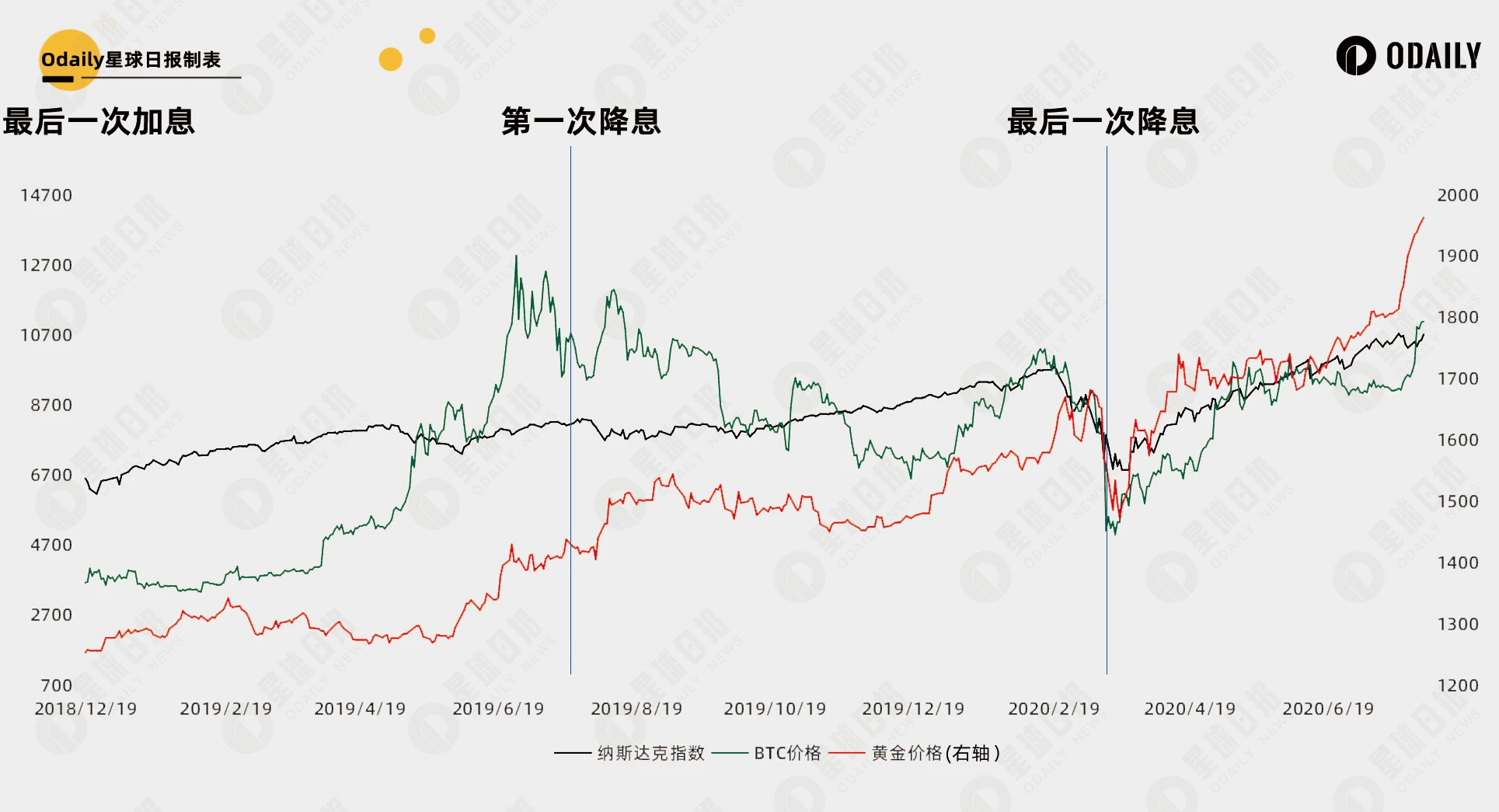Original | Odaily Planet Daily ( @OdailyChina )
Author|Nan Zhi ( @Assassin_Malvo )

At 20:30 on September 6, the U.S. Department of Labor released non-farm data. The seasonally adjusted non-farm payrolls in the United States in August were lower than expected. BTC rose accordingly, rising from 55,900 USDT to about 57,000 USDT in a short period of time. However, one hour after the data was released, BTC began to lead the entire crypto market to fall.
OKX market data shows that the highest price of BTC today is 57008 USDT, and the lowest price fell to 53800 USDT at 23:00, a drop of 5.7%.
ETH fell from 2400 USDT to 2264 USDT during the same period, a drop of about 5.7%;
SOL fell from 134 USDT to 126.7 USDT, a drop of about 5.5%;
BNB fell from 509 USDT to 488 USDT, a drop of about 5.2%.
Affected by the decline of BTC, the total market value of cryptocurrencies has also fallen sharply. According to CoinGecko data, the total market value of cryptocurrencies has fallen to 2.06 trillion US dollars, a 24-hour drop of 4.63%.
In terms of derivatives trading, Coinglass data shows that in the past 24 hours, the entire network has liquidated $160 million , most of which are long orders, amounting to $124 million. In terms of currencies, BTC liquidated $74.87 million and ETH liquidated $28.62 million.

Non-farm data and expectations of rate cuts
The data released by the U.S. Department of Labor are as follows: The seasonally adjusted non-farm payrolls in August were 142,000, expected to be 160,000, and the previous value was revised from 114,000 to 89,000. The unemployment rate in August was 4.2%, expected to be 4.20%, and the previous value was 4.30%. This data is in the middle of recession and overheating. A few days before the release of the data, the probability of the Federal Reserve cutting interest rates by 25 basis points in September was 69% . After the release of the non-farm data, the probability of a 25 basis point cut in interest rates rose to 75% .
Rate cut policymakers need more data support
At 23:00, Fed Governor Waller gave a speech on the economic outlook, but overall there was no incremental information. Waller said: The time has come to start a series of rate cuts this month. If the data supports continuous rate cuts, then I think continuous rate cuts are appropriate. If the data shows that a larger rate cut is needed, then I will also support it.
Regarding Wallers speech, analyst Cameron Crise said that the much-anticipated Waller speech triggered market volatility, and one of the striking remarks was that he would support strong action/early rate cuts if necessary. But the market overlooked the role of if in the sentence. Waller spent a considerable amount of time in his speech explaining why he was quite optimistic about the prospect of continued economic expansion, why the Sam rule was only descriptive rather than predictive, and how the kind of shock that has not yet appeared usually triggers a recession. He actually hinted that more data was needed to decide the final extent and pace of easing, so from his point of view, policymakers obviously have not decided how aggressive it will be. Combining these remarks with Williams earlier remarks, there is still no convincing evidence that the FOMC will cut interest rates by 50 basis points. It is also worth noting that Waller said that at a time when the Fed is implementing a series of rate cuts, I believe there is enough room to lower the policy rate and still maintain a certain degree of restraint to ensure that inflation continues to move towards the 2% target, which is reflected in the employment data. To some extent, the initial market reaction looks a bit overdone.
The key is the path of rate cuts, not the magnitude of the September cut
Feds Goolsbee gave a speech at 23:00: Todays employment data is a continuation of what we have been observing. The job market is slowing down. Inflation data every month is lower than expected. Policy has just been tightened, which raises some serious questions for this meeting and the next few months. We must ensure that the labor market does not deteriorate. The content of the Feds Beige Book is relatively pessimistic, suggesting that there are warning signs in the economy. The general consensus within the Fed is that there will be multiple interest rate cuts.
Asked about a bigger rate cut, Goolsbee said keep an eye on the dot plot, which doesnt show inflation falling so quickly or unemployment rising so high.
When asked whether there would be a 50 basis point rate cut in September, Goolsbee said the outcome of the next meeting itself was not the most important thing, and the path of rate cuts in the coming months was more important.
Market sentiment is generally bearish
Arthur Hayes: Not Selling, But Shorting
On the morning of September 6, BitMEX co-founder Arthur Hayes posted on the X platform that Bitcoin is expected to fall below $50,000 this weekend, and a cheeky short has been made.
However, two days ago, although Hayes was also bearish , he clearly stated that he would not sell: My change of opinion has kept my hand hovering over the buy button. I will not sell cryptocurrencies because of short-term bearishness. As I explained, my bearishness is only temporary.
Two days ago, Hayes explained in detail the reasons for his bearishness - although the Federal Reserve has been trying to curb inflation through continuous interest rate hikes since 2022, the governments huge fiscal spending is still the main reason for high inflation. Hayes believes that due to political pressure and election cycles, it is difficult for the government to significantly cut spending or increase taxes, which will cause the US economy to continue to hover under the dual pressures of inflation and growth . Faced with this situation, the Federal Reserve may no longer raise interest rates further, and the market itself may respond to high debt financing costs by adjusting interest rates. The 10-year U.S. Treasury yield may climb to 5% again, triggering a new round of fluctuations in the financial market.
In addition, Hayes also suggested that U.S. Treasury Secretary Janet Yellen may respond to market instability by issuing more short-term Treasury bonds (T-bills) and adjusting fiscal policies, aiming to increase market liquidity to prevent the financial system from getting into trouble due to rising debt costs. Hayes predicts that these measures will have an important impact on risky assets, including cryptocurrencies. Once the U.S. Treasury Department sends a signal of increasing liquidity, the cryptocurrency market may usher in new opportunities for growth. Especially with the continued swing in global central bank policies, crypto assets are expected to become the main choice for investors seeking hedging and risk aversion. Hayes emphasized that although Bitcoin prices may fluctuate in the short term due to liquidity tightening, in the long run, as liquidity is re-injected into the market, the bull market in cryptocurrencies is expected to restart.
Therefore, Hayes further expressed the view that he would not sell cryptocurrencies because of short-term bearishness.
Be a Fool Bullish on ETH and SOL, and Prepare for $900 ETH
On September 6, Zeneca, founder of ZenAcademy and The 333 Club , posted on the X platform, “The bull market may be over. I don’t think so, but (reality) may be so. You should have a plan just in case. For example, if Bitcoin falls for most of the next year and reaches $18,000, ETH reaches $900, and SOL reaches $28 ...are you ready?”
According to previous news, on August 8, Zeneca published an article stating that the herd mentality in the cryptocurrency market is very strong. Zeneca said that a year ago, if someone was optimistic about Solana, they would be considered stupid or completely ignored. Now, if you are not optimistic about Solana, you will be criticized. At the same time, he noticed that people who are currently optimistic about Ethereum are also considered stupid. Zeneca calls himself a proud fool because he is optimistic about both Solana and Ethereum .
Options data tends to be bearish in the short term
On September 5, Adam, a macro researcher at Greeks.live, wrote that the decline is still continuing and market confidence is continuing to decline. Today, a large number of put option transactions appeared in the bulk options market, accounting for nearly 30% of the total transactions, of which BTC Block Put transactions were 280 million US dollars and ETH Block Put transactions were 90 million US dollars. In terms of option data, the main term Skews are all deflected in the bearish direction, and the implied volatility has increased slightly. Overall, the options markets expectations for the future tend to be short-term declines.
On September 6, Adam wrote again: Cryptocurrencies have been falling all the way this week. The weakness of the entire market can be clearly seen from the options data. The recent decline in the biggest pain point has not kept up with the speed of price decline. The IV of the main term has increased. As the US election approaches, the IV bulge on October 8 is gradually being smoothed out.
As mentioned before, the trading data in previous years showed that September was generally a bit dull, but the market seems to be a bit overly pessimistic. We prefer to believe that there will be a bull market at the end of the year.
Before the bull or the beginning of the bear
Looking back at the last rate cut cycle , Bitcoin completed its gains ahead of the rate cut, and began to plummet and decline overall one month before the rate cut . It was not until the liquidity was completely released after the unlimited QE in March 2020 that the bull market of 2020-2021 was ushered in.
Currently, Bitcoin has also completed a similar early rise, but the subsequent improvement in liquidity is still unknown. The current priority is to stay alive and wait for this moment to come.











